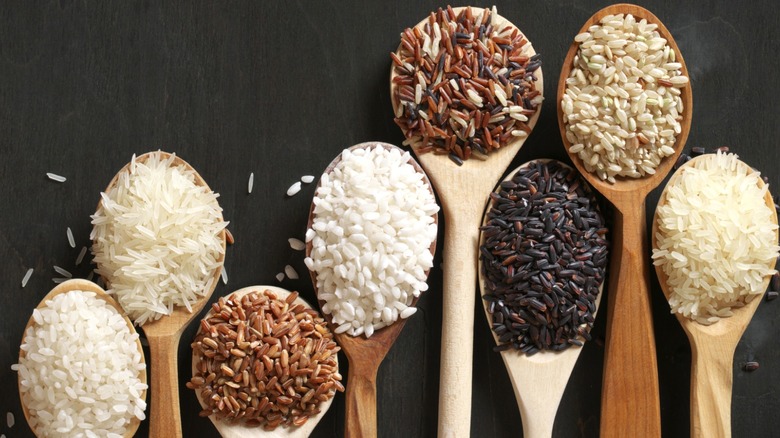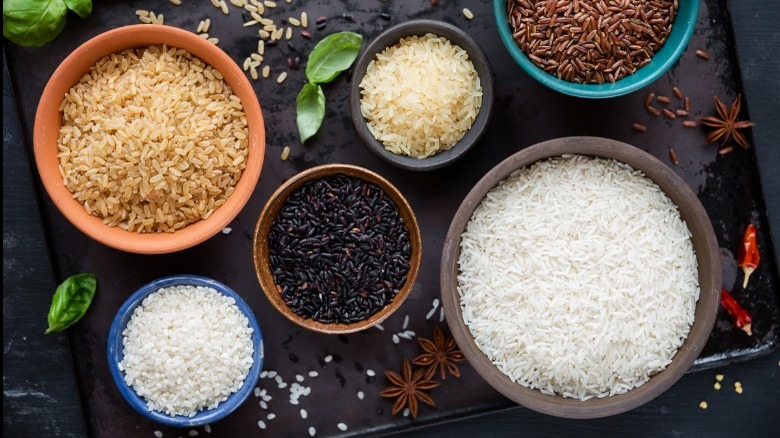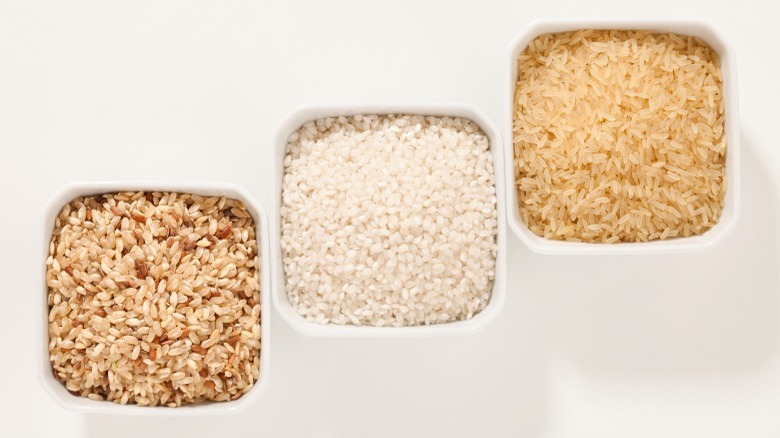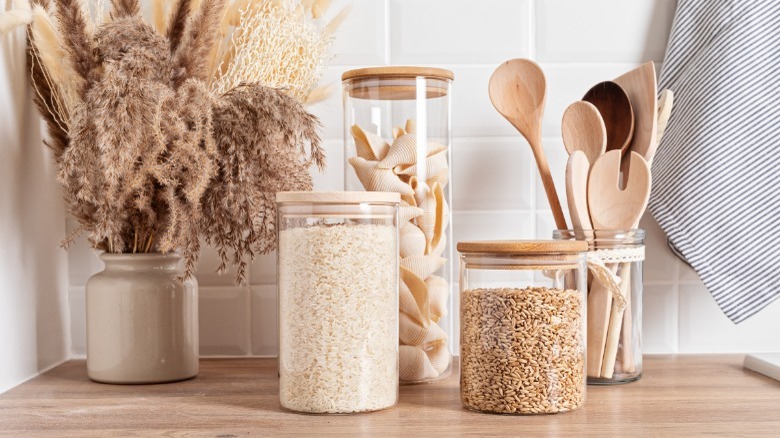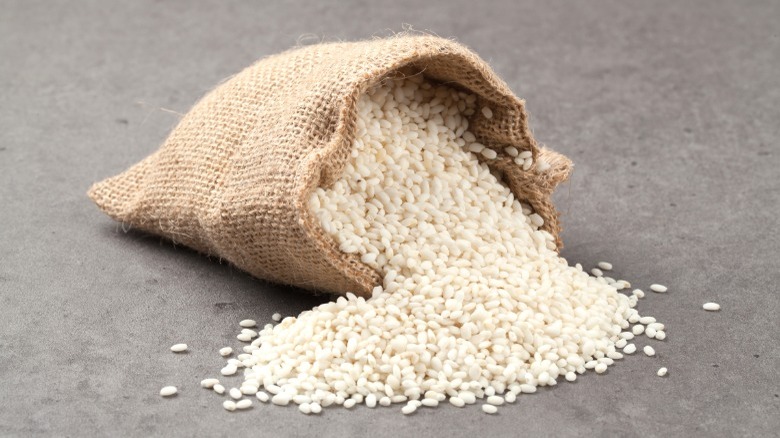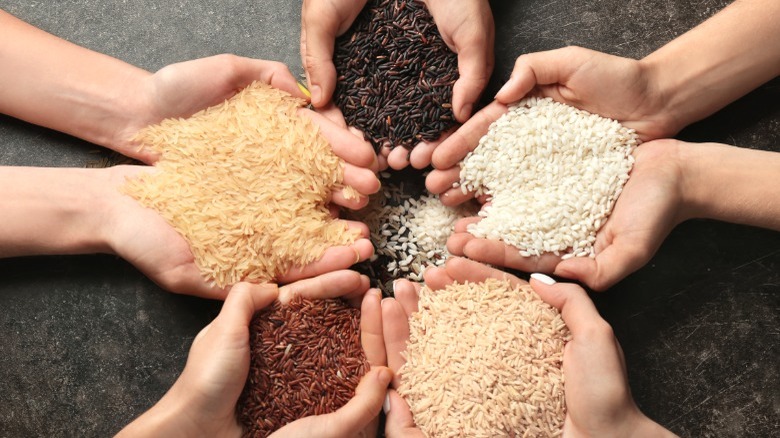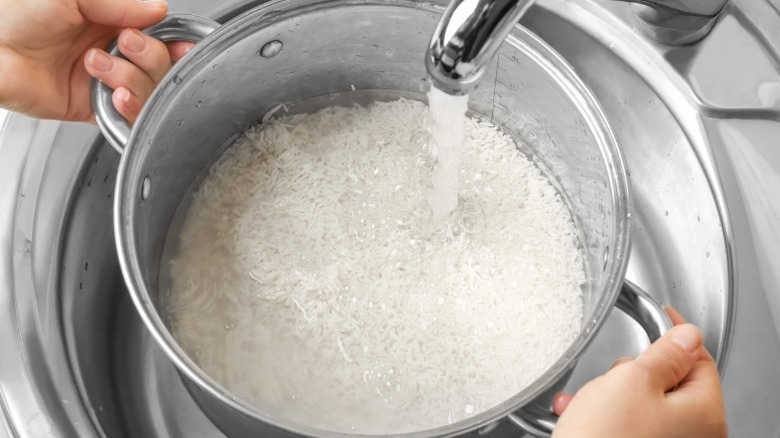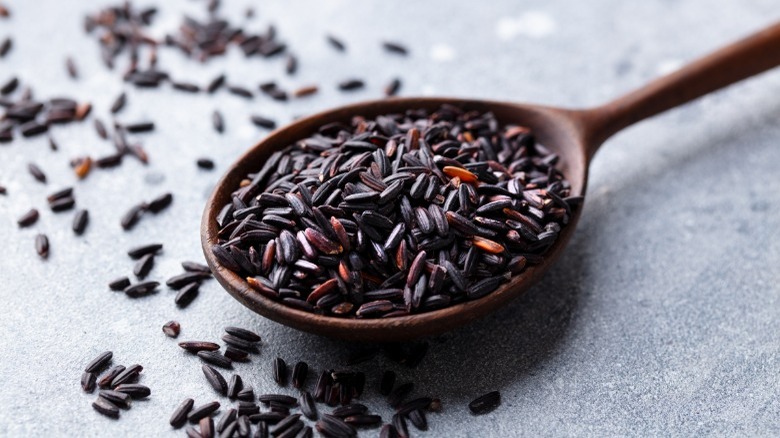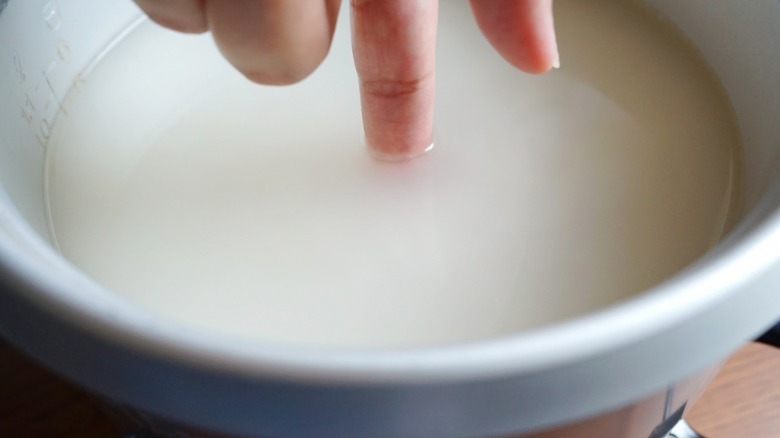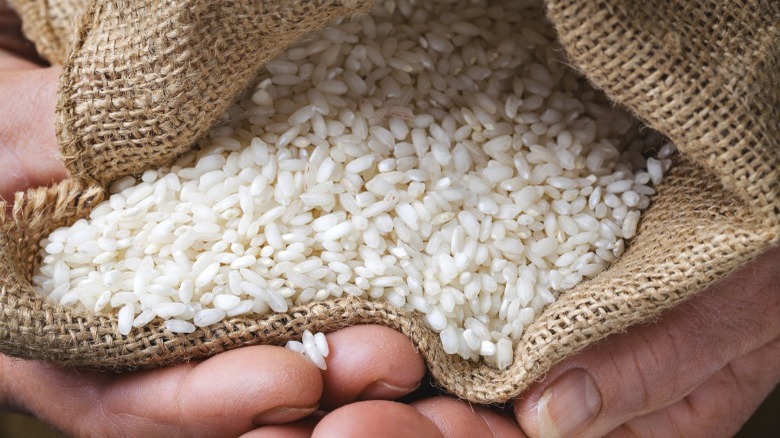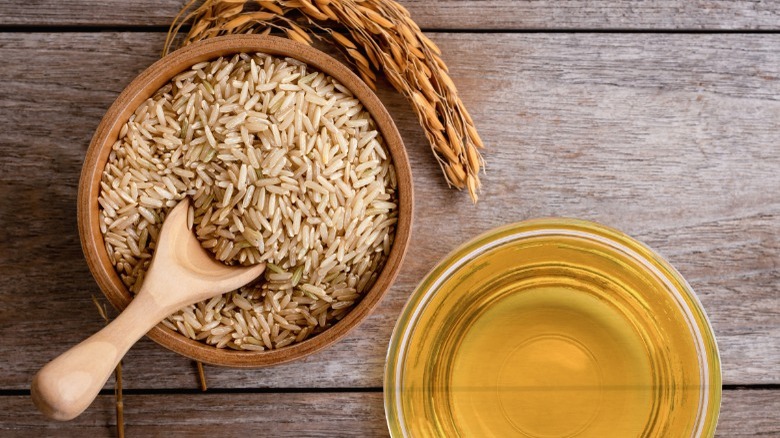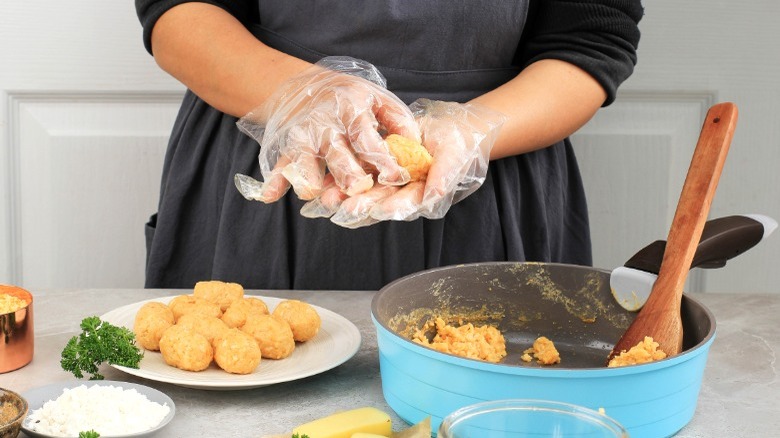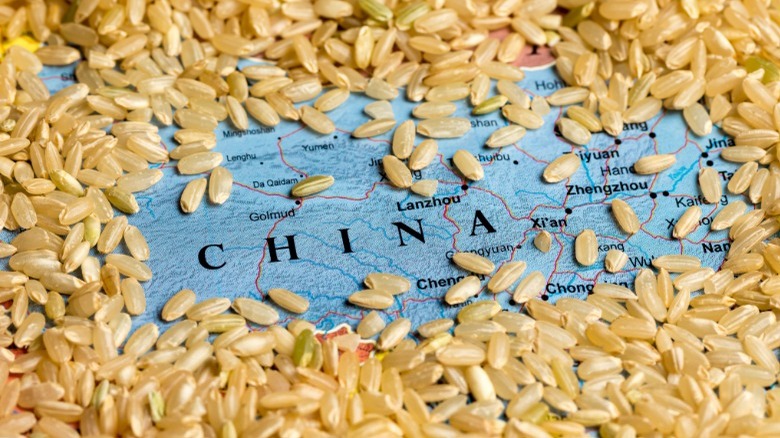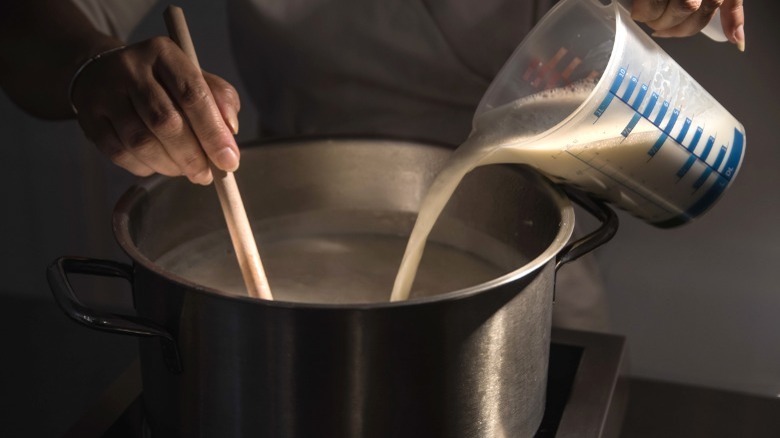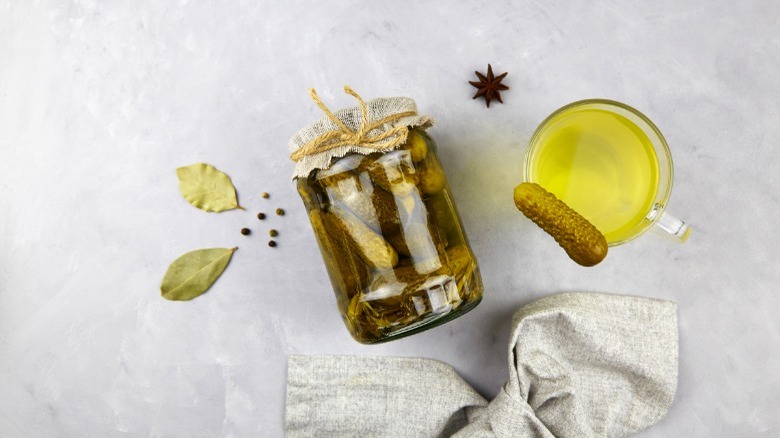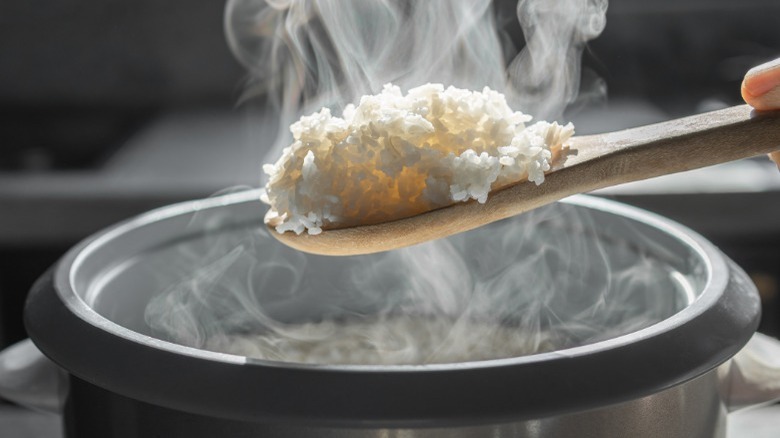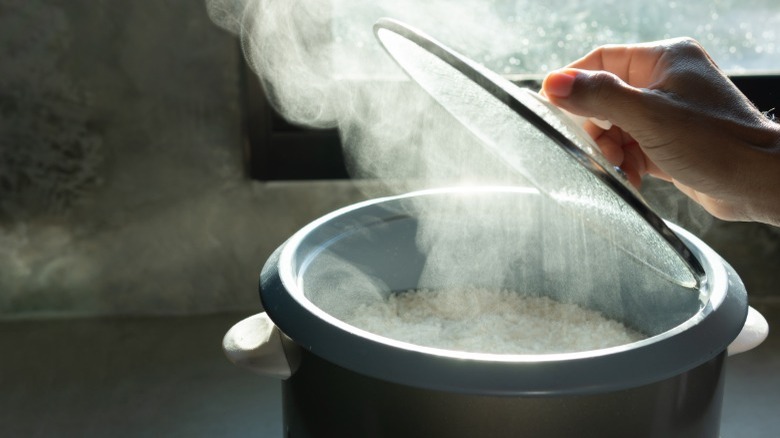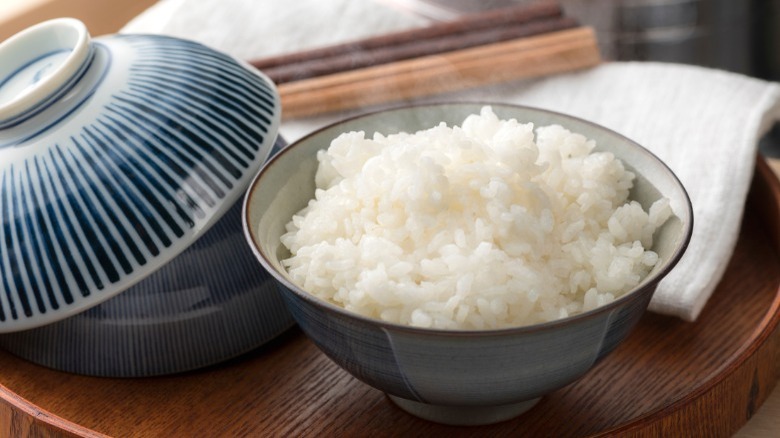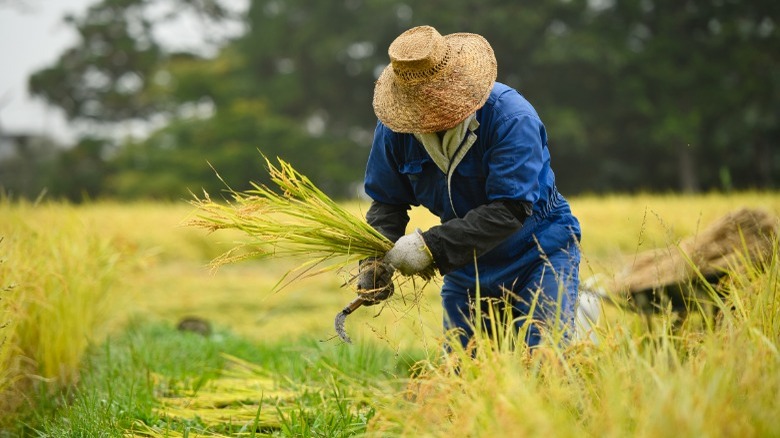Everything You Need To Know About Rice
As one of the most ancient staples of the human diet, rice has been an integral part of what we eat for centuries, and today it is consumed by billions of people worldwide. The rich and fascinating history of this versatile grain involves genetic mutations, illegal smuggling, space agriculture, and even using it as a building material. With thousands of years of practice, however, humans are still in the process of mastering proper methods of cooking and storing it. Each type of rice requires a different approach, making it a challenge to get the perfect texture and flavor.
Whether you're a seasoned cook or a novice, there's always something new to learn about this essential grain. So if you ever wondered how to make perfect fried rice at home, infuse more flavor into it, and use up leftovers creatively, read on to find out everything you wanted to know about rice.
There are thousands of varieties, but one outsells the rest
Rice is one of the most popular food staples worldwide, with over 120,000 varieties (via USA Rice). However, some types of rice are more common than others, and you've likely tried a few of them. There's the short-grained, round, and starchy arborio rice of Italian risotto fame, sweet Thai sticky rice, Japanese sushi rice reserved for its namesake dish, and phytonutrient-rich red and black varieties common in Asian cuisines. But there's one kind that outsells them all. The world's most popular variety of rice is indica, which includes long-grain varieties with lower starch content, such as jasmine and basmati. Aromatic basmati rice is almost always used in Indian dishes, whereas jasmine rice is popular worldwide because it cooks quickly and has a fluffy, light texture.
The Great Wall of China was built with rice
You knew rice was an ancient grain. But did you know it's also an ancient building material? One of the most famous historical landmarks in the world, the Great Wall of China, was constructed using an unlikely material — rice! During the reign of the Ming Dynasty (1368-1644), the abundant and inexpensive glutinous rice flour was mixed with lime and water to make the first-ever composite mortar. Its high starch content helped the mortar to harden and become more resistant to erosion. This combination of rice and lime was also used to waterproof the wall (via Ripley's). The ingenious use of rice in the construction of the Great Wall allowed for parts of it to be well-preserved and weed-resistant for centuries.
The difference between brown, white, and enriched rice goes beyond nutrition
Brown, white, and enriched rice all have different nutritional values and cooking processes. The reason you shouldn't cook white and brown rice the same way has to do with the ways the grains are processed. White rice is stripped down to the starchy endosperm, whereas brown rice is kept as a whole grain, with the outer bran and germ layers intact. This explains the nutritional difference between the two: There's more fiber, vitamins, and minerals in brown rice, but it also takes longer to cook and requires more water. Enriched rice falls somewhere in the middle: It's still milled white rice but with added B vitamins and iron. It cooks similarly to regular white rice, with one important difference: you're not supposed to rinse it, as it might wash away some of those nutrients.
You might be storing it wrong
To get the most out of your rice, you should actively try to extend its shelf life and freshness. For one, you should stop storing uncooked rice in the pantry, as it will greatly benefit from being kept in a dry, airtight container in a cool, dark place, such as the fridge or the freezer. This way, depending on the variety, it will stay fresh from a few months to a few years. Similar principles apply when storing cooked rice: An airtight container in the fridge will allow it to last four to six days. It would also help to use a scoop or spoon to get the amount of rice you need instead of using your hands to keep the rice from getting contaminated.
Sticky rice was born out of genetic mutation
Glutinous rice, known colloquially as sticky rice, is a unique type of rice that is characterized by its chewy texture and gummy consistency. This variety was born out of a genetic mutation that resulted in the absence of amylose, a type of starch that is present in most other rice varieties. Without amylose, the rice grains are able to absorb more water, leading to a sticky and glutinous texture when cooked. Sticky rice is a staple ingredient in many Asian cuisines and is particularly adored in Laos, where the annual per-capita consumption of the grain exceeds 345 pounds. Sticky rice owes its popularity to its versatility and unique texture, which make it an ideal ingredient for steaming, boiling, and baking.
Picking the right kind of rice is essential
There are reasons why some traditional dishes opt for certain kinds of rice over others. Mix them up, and there's a culinary disaster on your hands. For example, you should never use long-grain rice for risotto, as it won't absorb the flavors or be creamy enough. This is why risotto and traditional paella always use short-grain rice, such as arborio or Bomba. On the other hand, the ability to absorb the flavors while retaining a fluffy texture makes basmati rice crucial for biryani. This aromatic variety is high in amylose, which prevents the grains from sticking together. When selecting rice, it is important to remember the type of dish you are making and select the best kind of rice for it.
You can skip the rinse (but you really shouldn't)
Rinsing rice before cooking is a common step for many varieties, particularly those with a high starch content, such as basmati, jasmine, and sushi rice. And while it is possible to skip rinsing rice in a pinch, it is not recommended unless you're cooking enriched rice. There are several reasons why rinsing rice is more crucial than you think. Aside from removing any dirt, dust, or debris that may be present on the rice, rinsing can positively affect the texture and flavor of the cooked rice. It helps remove excess starch, which can lead to the cooked rice grains becoming clumped together and producing a gummy texture, rather than the fluffy and separate grains desired in many dishes.
Wild rice isn't rice
There is a reason wild rice stands out among other varieties in terms of nutrition and presentation. It's known to contain the highest amount of protein per cup compared to other common rice varieties. Additionally, wild rice has a chewy texture and nutty flavor that sets it apart from other types of rice and makes it a versatile ingredient in a variety of dishes, wild rice sauté being one of them. But don't let the name confuse you — it's not wild, and it's not rice. Rather, it's a type of cultivated grass seed that is harvested and consumed as a grain. It is called wild rice because it is grown in natural habitats, such as lakes and rivers, rather than in rice paddies.
You can ditch the measuring cups for the knuckle method
The traditional method of measuring rice and water using cups can be unreliable and lead to unevenly cooked rice. Fortunately, there is a cooking method that ditches conventional measuring rules and uses the knuckle method instead. It involves using the length of your index finger to determine the right amount of water to add to the pot. To use this intuitive method, simply place your index finger on top of the rice in the pot, with your fingertip touching its surface. The water level should reach the first knuckle on your finger. This ensures that you are adding the right amount of water for the amount of rice you are cooking and eliminates the need for measuring cups.
Thomas Jefferson smuggled rice into the US
Thomas Jefferson is well known for his contributions to American history, but few people know that he was a bit of a foodie who was always on the lookout for new foods to bring back to the United States from his travels abroad. During one of his trips to Europe, Jefferson discovered a variety of Italian rice that was considered a delicacy in Europe. Impressed by its quality and flavor, Jefferson decided to smuggle some back to the U.S. Despite the strict laws against importing plants and seeds into the country, he concealed the rice seeds in his pockets and brought them back to the United States without the knowledge of customs officials. Talk about a true passion for rice.
Adding fat to rice will elevate its flavor
If you ever asked yourself whether you should add butter to rice, the answer is yes. Adding butter or any other fat to rice is a simple and effective way to elevate its flavor and texture. It coats the grains and prevents them from sticking together, resulting in a flavorful, creamy, and fluffy bowl.
Compared to dairy butter, one of the benefits of adding oil to rice is that it has no cholesterol, making it a healthier alternative. Coconut oil is particularly heart-friendly, as it contains lauric acid that can boost the "good" HDL cholesterol. Additionally, it can make rice more digestible by altering its resistant starches — only ½ teaspoon of oil per ½ cup of rice will do the trick.
Eating leftover rice is safe – and you can get creative with it
Leftover rice is a common occurrence, and the question of whether it is safe to eat can often arise. The good news is that you can enjoy it for three to five days as long as it is stored properly. To ensure that leftover rice is safe to eat, it should be cooled down completely before being put in the fridge in an airtight container.
The versatility of leftover rice makes it an excellent ingredient to have on hand, and a little creativity can transform it into something exciting. Some delicious ways to use up leftover rice include fried rice, arancini, frittata, rice pudding, and risotto. So, next time you have leftover rice, get creative and make the most of it.
China grows the most rice
It's no surprise that most of the world's rice comes from China, considering it's the birthplace of the crop. Today, it accounts for 28% of global rice production (via World Economic Forum). But its ventures in rice production don't stop there. Over the past decade, China has also become a leader in space agriculture. As a result, rice was successfully grown in space aboard the Chinese spacecraft, Tiangong-2. After years of experimenting, in 2022, they were finally able to grow rice in a controlled environment, providing a potential food source for future space missions. With its investment in rice cultivation and research, China is poised to continue to play a major role in feeding the world's growing population, both on and off the Earth.
You can experiment with cooking liquids
If you're tired of eating plain rice, there is an easy trick to make it more exciting: substitute water for another liquid. Obviously, the easiest way to add extra flavor to your rice is by cooking it in broth, which can provide a rich and comforting flavor. On the other hand, a surprising ingredient that can be used to cook rice is orange juice, which will lend a mild, sweet, and tangy flavor in addition to a yellowish hue. This method is especially good for curries, salads, or stir-fries, where a light taste is desired. Finally, coconut milk can also be used as a cooking liquid for rice, particularly when making rice pudding. The milk and sugar create a creamy, rich base for the pudding, and you can add more flavorings to taste.
There's a simple trick to fried rice
When making fried rice at home, leftover grains are the way to go. It naturally dries out as time passes, creating a better texture for frying than freshly cooked rice. However, to achieve restaurant-level quality at home, you need to master three things: heat, tosses, and wok hei, or the keys to why fried rice tastes better at a restaurant. Applying high heat directly to the wok, along with rhythmically tossing the ingredients together with a spatula, is an integral part of making quality fried rice. The high heat of the wok helps to sear the ingredients and creates a crispy texture on the outside while also distributing the flavors evenly throughout the dish — which is the essence of 'wok hei.'
You can season it with pickle brine
Lovers of sushi rice are no strangers to mixing it with salt, sugar, and vinegar to achieve a new, complex flavor. But there's another, less conventional way to season rice that yields similar results. What's more, it's accessible, low-waste, and pantry-friendly. That's right; we're talking about leftover pickle juice. It's rich in vinegar, salt, and spices, which provide a sour and savory taste that complements different types of rice.
You could stir in the pickle juice right before serving or go all out and add it to the cooking water. The amount of pickle juice you should use depends on your personal taste, but a good starting point is about 2 to 3 tablespoons for every cup of cooked rice.
There is no difference between simmered and steamed rice
Simmering and steaming rice are often considered to be two separate cooking methods, but, in reality, the difference between the two is negligible. Both involve cooking the rice in water over low heat until tender. Simmered rice is typically cooked with a larger amount of boiling water, which is added straight to the rice, and then reduced to a simmer under the lid until it's absorbed by the rice. Steamed rice, on the other hand, is made by adding a small amount of water to the rice and placing it in the steamer filled with cold water, which is then brought to a boil and reduced to a simmer. Despite these slight differences, simmered and steamed rice are basically the same thing, both resulting in a fluffy and versatile grain.
You should keep the lid on during and after cooking
Checking in on rice as it cooks is tempting and understandable — you don't want it to overcook and burn. Wanting to dig in as soon as the stove is off makes total sense — you're hungry, and you've been waiting for over 20 minutes! But rice requires a more hands-off approach. The reason why you need to stop checking rice as it cooks has everything to do with heated water vapor trapped under that lid, which helps the rice cook evenly and become soft and fluffy. If you're aiming for stickier rice — for example, if you're making sushi — letting the rice sit in the covered pot for additional five to 10 minutes is essential to finish steaming and reach the right consistency.
Adding salt is a must – but there is an exception
Adding salt is important when cooking rice because it plays a crucial role in how it will turn out. When mixed into the cooking water, salt helps enhance the rice's natural flavor and firm the grains up. A ½ to 1 teaspoon per cup of rice should do the trick, as long as you add it to the water before the rice.
However, the use of salt in rice cooking is not universal, and some cuisines, such as Chinese, Korean, and Japanese often skip it in favor of the natural flavors of the rice. Considering it's also often paired with umami-packed condiments and spicy toppings, omitting the salt allows the rice to become a neutral base for any dish.
An ice cube can be handy when reheating rice
If you're struggling to make leftover rice appetizing again, there is a clever hack you should use. While the hard, dried-out texture of leftover grains is preferred for fried rice, in almost every other scenario, you'd want to rehydrate it as you're reheating it. And that's when a humble ice cube comes in handy. If using the microwave, top your bowl of rice with it. Leave the bowl uncovered and heat it up for a minute. This allows the ice to evaporate just enough to steam the rice back into its plump, tender glory. And even though you'd expect it to melt, it doesn't — thanks to the hydrogen bonds that won't let frozen water molecules rotate and react to the microwave energy.
Climate crisis will change the way we eat rice
Rice is one of the most widely consumed crops in the world, with the average American eating about 20 pounds of it each year. However, as populations grow, temperatures rise, and weather patterns change, rice production is becoming more challenging and more expensive.
Rice is a highly sensitive crop and is particularly vulnerable to changes in temperature, precipitation, and soil moisture. These factors can lead to reduced yields, lower quality, and higher costs for growers. As a result, the cost of white rice is likely to rise, and we may see a shift towards more resilient varieties. Adapting to these changes and finding innovative ways to sustainably grow and eat this essential staple food are necessary.
